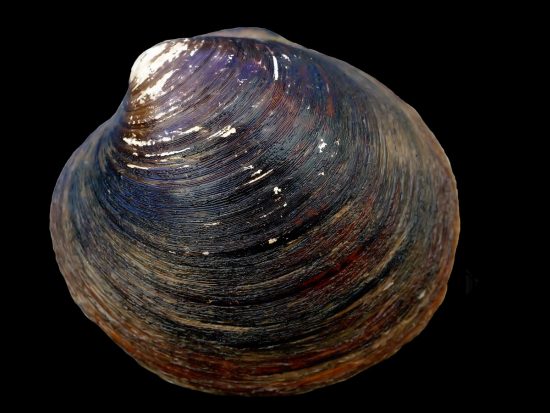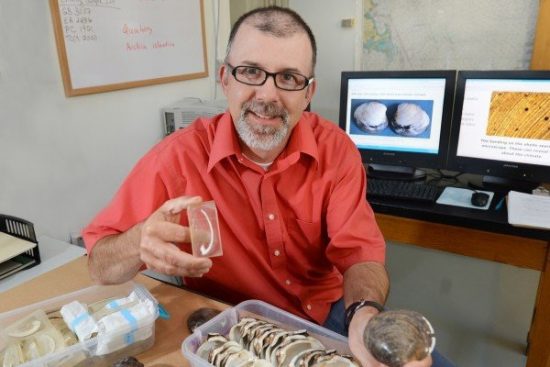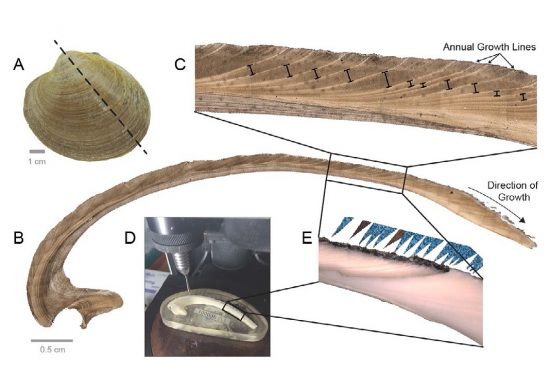




As a postdoctoral researcher at Bangor University in Wales from 2007 to
2009, Alan Wanamaker started the compilation of a 1,000-year-record of
the marine climate for a spot in the North Atlantic off the fjords and
fishing villages of North Iceland.
His research was based on thousands
of clams, specifically Arctica islandica, taken from 80 metres of
seawater on the North Icelandic Shelf.
The work involved sectioning shells, embedding shell slices in epoxy
blocks, measuring down to a millionth of a metre, drilling samples,
radiocarbon dating and determining oxygen isotopes. Then, he would
examine cross-sections of the shells, looking for patterns, matching
growth rings and finding overlaps.
His objective was to line up enough shells to build a master chronology
of growth increments covering a millennium.
After Wanamaker left Wales
in 2009, Paul Butler, now a research lecturer at Bangor University,
continued with the shell chronology and David Reynolds, now a
postdoctoral research associate at Cardiff University in Wales,
completed the isotope analysis.
The results of their findings, based on 10 years of work and the
analysis of nearly 1,500 isotope samples from dozens of clams, has been
published in the Nature Communications journal: “Here we report a new
1,048-year precisely dated, annually resolved marine oxygen isotope
record that spans the entirety of the last 1,000 years (AD 953-2000).”
Isotopes are elements with varying numbers of neutrons. Heavier oxygen
isotopes in the growth increments of shells are generally associated
with colder and denser seawater while lighter isotopes are associated
with warmer and less-dense seawater.
A step toward climate prediction?
This paper represents the first time researchers have produced a dated
and annual record of ocean conditions that goes back 1,000 years.
According to Wanamaker, now an Iowa State University associate
professor of geological and atmospheric sciences, “That's incredibly
difficult. You need a lot of material to make this kind of chronology.
And as you go back in time, there's less and less to work with.”
In addition, analysis of the annual record enabled the researchers to
examine how temperature, density and circulation changes in the North
Atlantic have affected changes in the broader climate system.
Specifically, it indicated that ocean variability had played an active
role in driving the main pre-industrial climate variability of the past
1,000 years. This variability included the warming of the Medieval
Climate Anomaly from about A.D. 950 to 1250 and the cooling of Europe's
Little Ice Age from about A.D. 1550 to 1850.
The largest discovery in the record so far?
In addition, the researchers also made another discovery: “The coolest
thing that came out of this record is that during the first 800 years
of data, ocean changes seemed to be leading atmospheric changes, or the
changes were at least simultaneous. But after 1800 and the industrial
revolution, the atmosphere seemed to take complete control,” said
Wanamaker.
The paper reports that the acceleration in atmospheric change compared
to ocean change is “probably driven by the faster response of the
atmosphere to the warming influence of greenhouse gases.”
Wanamaker added that they had not seen anything like that in the last
1,000 years. Now, he intends to build similar marine climate records
for other locations in the ocean. His own Iowa State research group is
collecting and analysing clam shells from waters off Maine and Norway.
Wanamaker feels that there is still more to learn about the association
between the oceans and the climate.
In their paper, the researchers
wrote that the shell record of ocean conditions “provides a long-term
baseline for the state of the North Atlantic coupled climate system and
demonstrates that the role played by the ocean in naturally forced
climate variability should be a key focus if we are to realise the
societally crucial step forward in near-term climate prediction.”
For now, with the publication of the paper, Wanamaker feels that all
those years of sorting and studying clam shells had been worth the time
and tedium; as he says, “It's really gratifying to see this come to
fruition.”
Link to the study
 Herbert
Herbert 19th December 2016
19th December 2016